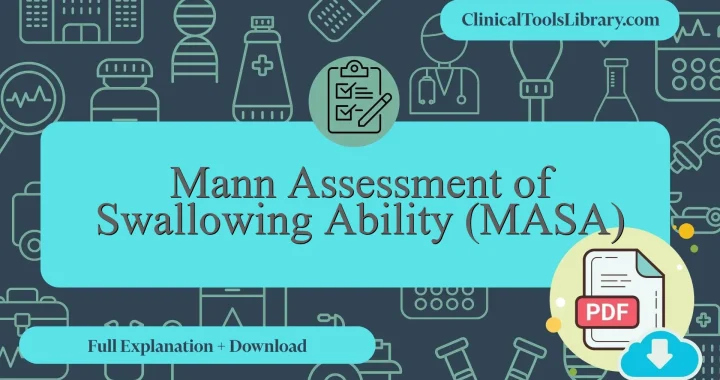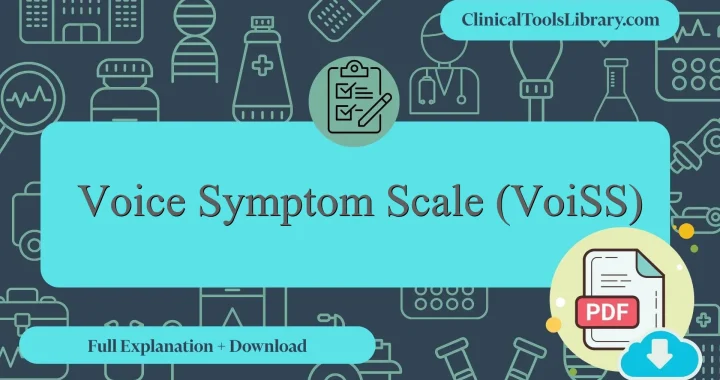In this article, we explain everything you need to know about the Mann Assessment of Swallowing Ability (MASA). We will cover the aspects it evaluates, the target population, a detailed step-by-step explanation, and how to interpret its results. Additionally, we will dive into the scientific evidence supporting this tool (diagnostic sensitivity and specificity) in clinical assessment. You will also find official and unofficial sources available for download in PDF format.
What does the Mann Assessment of Swallowing Ability (MASA) assess?
The Mann Assessment of Swallowing Ability (MASA) is a clinical tool designed to evaluate oropharyngeal dysphagia in patients, particularly those with neurological impairments or head and neck cancers. It systematically measures key components of swallowing function including alertness, cooperation, swallowing reflex, and motor activities, facilitating an objective MASA Assessment scoring that guides clinical decision-making. The assessment’s main purpose is to identify the severity of swallowing dysfunction and the risk of aspiration pneumonia, thereby informing appropriate intervention strategies. Clinicians often utilize resources such as the masa-c scoring sheet or refer to the Modified Mann Assessment of Swallowing Ability PDF for detailed Mann Assessment of Swallowing Ability scoring interpretation. The tool is also adapted in versions like the Mann Assessment of Swallowing Ability-Cancer and is available as a digital resource via the Mann Assessment of Swallowing Ability app, enhancing accessibility for thorough swallowing ability and function evaluation.
For which type of patients or populations is the Mann Assessment of Swallowing Ability (MASA) intended?
The Mann Assessment of Swallowing Ability (MASA) is primarily indicated for patients with neurological impairments such as stroke, traumatic brain injury, and neurodegenerative diseases who are at risk of dysphagia. It is most useful in acute and subacute clinical settings to objectively evaluate swallowing function and guide clinical decision-making regarding safe oral intake. The tool’s structured criteria enable clinicians to perform comprehensive bedside assessments, with validated MASA Assessment scoring facilitating early identification of aspiration risk. Additionally, the Mann Assessment of Swallowing Ability-Cancer variant expands applicability to patients with head and neck malignancies, addressing swallowing impairments related to oncologic treatments. The availability of resources such as the Mann Assessment of Swallowing Ability scoring interpretation enhances clinical utility by standardizing result interpretation across diverse patient populations.
Step-by-Step Explanation of the Mann Assessment of Swallowing Ability (MASA)
The Mann Assessment of Swallowing Ability (MASA) consists of 24 items designed to evaluate the risk and severity of dysphagia. It includes domains such as alertness, cooperation, respiratory status, and oral motor function, with questions addressing both clinical observations and patient history. Each item is scored on a structured scale, typically ranging from dichotomous (yes/no) to ordinal responses, allowing for quantification of swallowing ability. The total score, which can reach up to 200 points, guides clinicians in identifying swallowing impairments and determining the need for further instrumental assessments. The standardized format ensures consistency in assessing factors like tongue movement, coughing reflex, and vocal quality, critical for diagnosing aspiration risk in patients with neurological or structural swallowing disorders.
Downloadable MASA PDF Resources: Mann Assessment of Swallowing Ability for Healthcare Professionals
Healthcare professionals will find downloadable resources available below, featuring both the original and English versions of the Mann Assessment of Swallowing Ability (MASA) in PDF format. These documents include essential tools such as the MASA Assessment scoring and the Modified Mann Assessment of Swallowing Ability PDF, which facilitate a comprehensive evaluation of swallowing function. The availability of these resources supports accurate and efficient clinical decision-making in managing patients with swallowing disorders, including those affected by cancer.
How to interpret the results of the Mann Assessment of Swallowing Ability (MASA)?
The Mann Assessment of Swallowing Ability (MASA) test yields a quantitative score used to evaluate the risk and severity of dysphagia, particularly in patients with neurological impairments such as stroke. Scores range from 0 to 200, with a cut-off of 170 indicating safe swallowing function; scores below this threshold suggest increased risk of aspiration and compromised airway protection. Interpretation requires comparison against established reference values: scores between 170 and 200 classify swallowing as normal or mildly impaired, 140 to 169 indicate moderate dysphagia, and below 140 reflect severe dysfunction. In practical terms, healthcare professionals use these results to guide the implementation of tailored interventions, such as diet modifications or referral for further instrumental assessment, and to monitor progress over time. The risk percentage can be approximated using sensitivity and specificity data associated with each score range to estimate aspiration likelihood, assisting clinical decision-making in multidisciplinary care planning.
What scientific evidence supports the Mann Assessment of Swallowing Ability (MASA) ?
The Mann Assessment of Swallowing Ability (MASA) test, developed in 2002 by Dr. Robert Mann, is a standardized clinical tool designed to evaluate dysphagia severity in patients, particularly those with neurological impairments such as stroke. Validation studies have demonstrated strong interrater reliability (ranging from 0.82 to 0.91) and construct validity when compared with instrumental assessments like videofluoroscopic swallow studies (VFSS). Subsequent research has corroborated its sensitivity and specificity in identifying aspiration risk, contributing to its widespread adoption in acute and rehabilitation settings. Additionally, the MASA’s comprehensive scoring system encompasses multiple physiological domains, facilitating a nuanced clinical profile that aids in individualized treatment planning for conditions including Parkinson’s disease and head and neck cancer-related dysphagia. These findings underscore the test’s empirical foundation and its utility as an evidence-based screening instrument.
Diagnostic Accuracy: Sensitivity and Specificity of the Mann Assessment of Swallowing Ability (MASA)
The Mann Assessment of Swallowing Ability (MASA) demonstrates a sensitivity ranging from approximately 70% to 85%, indicating its effectiveness in correctly identifying patients with dysphagia. Specificity values are generally reported between 70% and 95%, reflecting its accuracy in ruling out individuals without swallowing impairments. Variability in these metrics is influenced by patient populations and clinical settings, but overall, MASA remains a reliable bedside screening tool for assessing swallowing function in acute stroke and other neurologically impaired patients.
Related Scales or Questionnaires
The Mann Assessment of Swallowing Ability (MASA) is often compared to other validated tools such as the Toronto Bedside Swallowing Screening Test (TOR-BSST), the Eating Assessment Tool (EAT-10), and the Functional Oral Intake Scale (FOIS). Each offers distinct advantages: TOR-BSST provides a quick bedside screening with good sensitivity for stroke-related dysphagia, while EAT-10 is a patient-reported measure useful for identifying subjective swallowing difficulties. FOIS offers a functional categorization of oral intake, valuable for treatment monitoring. However, MASA stands out with its comprehensive clinical examination and detailed MASA Assessment scoring, enabling nuanced evaluation, including application in the Cancer population, as detailed in the MASA cancer PDF. Disadvantages of alternatives include potential subjectivity in patient-reported tools and limited scope in FOIS. All of these scales, along with the Modified Mann Assessment of Swallowing Ability PDF and the masa-c scoring sheet, are thoroughly explained and available for download on ClinicalToolsLibrary.com, facilitating informed selection based on clinical needs.




